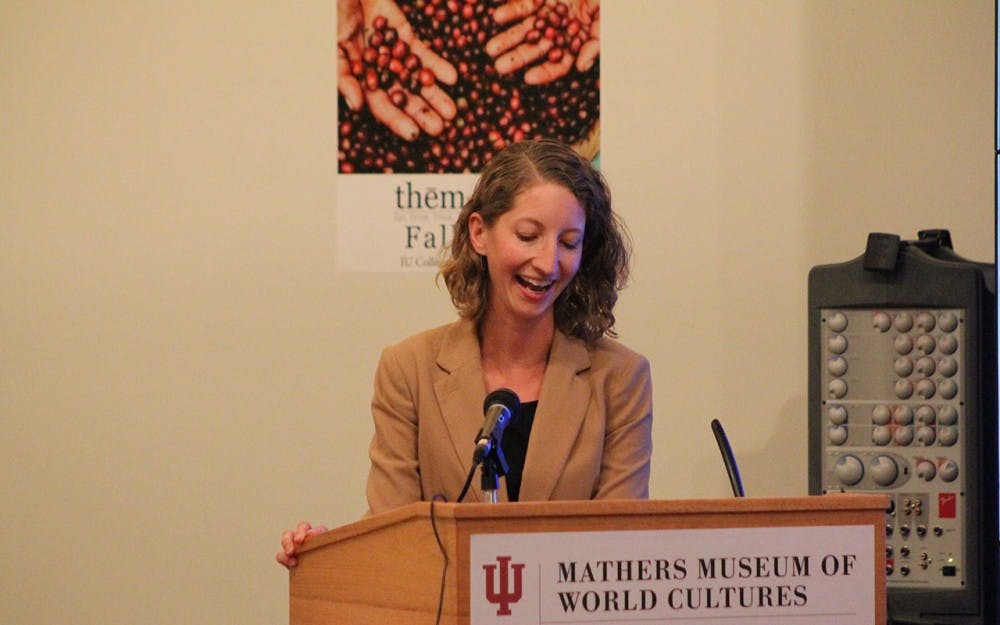The Mathers Museum of World Cultures’ exhibition “Siyazama: Traditional Arts, Education, and AIDS in South Africa” explores the role of art in the midst of a health crisis that still plagues the nation.
On Tuesday evening, the museum had a series of presentations and a panel discussion titled “Health, Healing & the Arts,” which featured perspectives from a variety of professionals on the topic of arts and healing in other parts of Africa and African diaspora communities abroad.
Molly Rosenberg, an assistant professor in the Department of Epidemiology in the School of Public Health, moderated the discussion and introduced the panelists, each of which focused on a different geographic area and the role art plays in the health and well-being of the people they have observed.
“I feel a little like I snuck onto this panel because, as an epidemiologist, I have little to no experience with art, besides vigorous armchair appreciation and advanced doodling,” Rosenberg said. “I’ve always been interested in how our health is shaped by our communities, our socioeconomic status, and our social and cultural involvement.”
Given this framework, the first to present was Daniel Reed, associate professor of ethnomusicology in the Department of Folklore and Ethnomusicology.
Reed focused on two dancers who emigrated from Côte d’Ivoire and demonstrated the healing power of dance in their daily lives.
“I encountered many examples of turning pain and difficult circumstances into beauty,” Reed said. “I’ve done research on HIV/AIDS entertainment campaigns and found in Côte d’Ivoire wonderful examples of how such campaigns use music that is joyous and happy to communicate often difficult messages.”
One of those examples was Vado Diomande, a New York-based dancer and previously part of the Ballet National de Cote d’Ivoire. Diomande used enthusiastic traditional dance forms to cope with multiple health issues, including flesh-eating bacteria, tumors and severe knee pains, and find opportunities for personal growth.
“In terms of takeaways, for the Ivoirian immigrants I’ve come to know, health, belief and dance are conceptually integrated,” Reed said. “Multiple health paradigms coexist in their eyes.”
Ruth Stone, professor of ethnomusicology and African studies, presented next on her work with sonic and musical connections made by citizens of Liberia during the recent Ebola crisis.
Stone followed the work of singer Juli Endee, who wrote a variety of jingles on the topic of Ebola in Liberia to spread awareness and who also started Crusaders for Peace, an organization dedicated to providing humanitarian services through conflict resolution.
Endee’s jingles included one with the lyric “Ebola is real,” a call to fellow community members to acknowledge the disease as more than superstition.
“In this way the titles resemble proverbs, concise sayings that all constitute a mainstay of local wisdom in Liberia,” Stone said. “They index the more extended exposition of an idea and pointed to important truths that permeated folk tales, everyday speech, court cases and other aspects of oral tradition.”
Stone also followed the role of church choirs, which help to knit together communities. The religious groups provided a sort of auditory connection during a time in which physical touch was largely discouraged due to the spread of disease.
Dr. Robert Einterz, director of the IU Center for Global Health, presented his work co-founding the Academic Model Providing Access to Healthcare arm in Kenya and the Imani workshops, which provide art therapy for the ill in Kenya.
“We built this Riley Mother Baby Hospital, and, as we put it up, we recognized that nowhere in sub-Saharan Africa is there a child life program such as what we are all so familiar with in the United States — one that, in part, relies upon art as a way to help children understand their disease and also to cope with their disease,” Einterz said.
Einterz also highlighted tragic stories of loss due to HIV and AIDS, as well as the ways in which multiple women learn skills through Imani that could also help them find economic security following husbands’ leaving, losing jobs because of an HIV diagnosis or children’s succumbing to illness.
The program concluded with a panel, during which Rosenberg asked the panelists how art, public health and empowerment are linked in each of their experiences.
“One of the things that happens when people perform is there is an emotional response,” Stone said. “We have to learn to somehow understand the aspects of that as we learn to work with people who are creating these things.”




